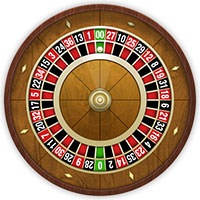"Waiting for a "C"
 This is one of the simplest strategies, and it is designed for a single game session, which lasts 37 spins (ball launches). After a number has fallen out twice (not necessarily in a row) you need to start betting on it. If several numbers fall out twice during the session, you should bet on them all. The explanation of the strategy is simple - it is based on the mathematical regularity of 2/3, according to which the full cycle of the game (37 spins) falls not more than 24 different numbers, therefore, one third of them is repeated more often than twice - three times or more.
This is one of the simplest strategies, and it is designed for a single game session, which lasts 37 spins (ball launches). After a number has fallen out twice (not necessarily in a row) you need to start betting on it. If several numbers fall out twice during the session, you should bet on them all. The explanation of the strategy is simple - it is based on the mathematical regularity of 2/3, according to which the full cycle of the game (37 spins) falls not more than 24 different numbers, therefore, one third of them is repeated more often than twice - three times or more.
CyberHyroller system
The system is suitable when falling numbers begin to repeat themselves and is designed for 13 spins. It is necessary to place bets on the system before some of them are played. As soon as the right number has fallen out, we start betting again.
We act as follows. You don't need to bet in the first back, in the second you need to bet on the number fallen in the previous back, in the third - on the numbers fallen in the first and second spins. In the fourth - all the numbers that fell earlier. We repeat the same thing to the seventh spin. In the eighth back, when it is necessary to put on eight numbers, on each number is put on two chips. We do the same in the ninth - two by nine numbers. In the tenth back the bet is already three chips per number, in the eleventh - four, in the twelfth - 6.
This system is a good opportunity to calculate losses in advance. If you stop playing on the ninth back, 62 chips will be lost. After the tenth - 92, after the eleventh - 136 chips. If you fail to play all twelve losses will be 208 chips.
Thomas Donald's strategy
This is one of the most authoritative systems, repeatedly tested by mathematicians. Its meaning is that the bets increase in case of loss and decrease in case of winning by 1 unit, but only comparable bets are placed (red/black, 1-18/19-36). The fallen zero is equal to the loss.
It makes sense to start working on the system only if the player has at least 3 thousand game units. The system is good only for players with high stakes.
Martingale's strategy
The point of this strategy is that after each loss you should double the bet and do so until the bet wins. Winning in this case will be an amount equal to the sum of all losses plus the profit equal to the original bet.
For example, if you bet $1 on red, you will earn $1 if you win (which is now 1:1). Then continue to play by betting on the same size ($1) and color. Do so (without changing the size of the bet and the color on which you bet) should be done either before you leave the game or before the first loss. In case of loss your losses are 1 dollar. Now you need to increase your bet by doubling it.
If you win again, you have recovered the loss and made a profit in dollar. If you lose - double the bet again (now it should be 4 dollars), continuing to bet on the same color. In case of loss, the bet doubles again ($8), and so on until the bet still does not play. Winning in this case is the amount equal to all the money lost before plus the amount of $1 - the amount of your initial bet.
Here is a rough calculation of the bets: $1 + $2 + $4 + $4 + $8 = $15. Counting the profit amount ($1 won) - you have regained your resources and income.
The amount of 1 dollar is selected conditionally - the initial bet can be any, but still the strategy does not recommend betting more than 5 dollars.
Martingale's strategy is very famous and popular. However, we do not recommend you to use it, because sooner or later it will lead to the fact that you will lose your deposit.
D'Alambert's strategy
The strategy is similar to that of Martingale, but less risky. It is based on the principle of balancing external rates (black and red, 1-19, 18-36, even and odd). Place bets in almost the same way as when using the strategy of Martingeyl: starting with a maximum of 5 dollars, doubling when losing, but in case of luck reducing the bet.
For example, you start the game with one dollar. If you win, you continue to bet on the same number or color again, in the same size, and if you lose - increase the size of the original bet (on the dollar) of each of the subsequent bets. As soon as one of the bets is played after losing, you start to reduce the bet, again by a dollar. Play until the betting amount is reduced back to one dollar.


